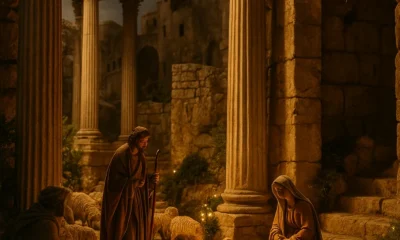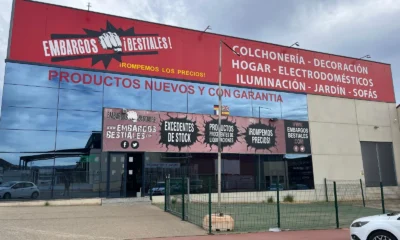Nature & Environment
AVE Almeria 2025: €8.2 M Boost Drives High-Speed Train Progress to 67 %
Published October 16, 2025 | Category: Infrastructure, Real Estate & Economy
TL;DR: The AVE Almeria high-speed train project has advanced from 50% to 67% completion, strengthened by a new €8.2 million investment on the Vera–Almeria section. Despite challenges, the line remains on track for its 2027 arrival.
AVE Almeria & High-Speed Train Almeria: Progress, Challenges and 2027 Outlook
The long-awaited connection between Almeria and Spain’s national high-speed rail network continues to make tangible progress. The AVE Almeria project, which had already surpassed the halfway point earlier this year, now stands at 67% completion thanks to a new €8.2 million investment by Adif for the Vera–Almeria section. (Cadena SER)
From 50 % to 67 %: where the project stands
Earlier this year, VisitingAlmeria.com reported that works on tunnels, viaducts and track structures were progressing ahead of schedule. Since then, progress has accelerated, with new funding allocated for traviesas bibloque and reinforced concrete slabs. These are key for constructing around 10.7 km of slab track (“vía en placa”), replacing traditional ballast systems.
Most of this section passes through complex engineering works, including the Sorbas Tunnel (7.5 km, the longest in Andalusia), the Gafarillos Viaduct (434 m) and the Almendral Tunnel (1.1 km). These upgrades are essential to ensure maximum speed, durability and safety of the line. (Cadena SER)
Timeline, arrival date & underground integration
According to official figures, the works are now 67 % complete. The Ministry of Transport, the Junta de Andalucía and the Almeria City Council reaffirm that the high-speed train Almeria remains on schedule for completion in late 2026, followed by an official opening in 2027. (Canal Sur)
One of the costliest stages is the soterramiento (underground section) within the city. More than €21 million in additional funds have been earmarked to integrate the new line into Almeria’s urban fabric while improving mobility and city aesthetics. (Canal Sur)
Debate and risks
Despite the positive progress, some political voices warn of risks to the project. Rafael Hernando, national deputy for Almeria, has stated that issues like energy capacity, water supply and industrial connections still need to be fully addressed — otherwise, delays could arise. (La Razón)
These concerns add to broader debates over sustainability and cost control. Yet, the government maintains that timelines remain stable and environmental conditions are being respected.
Environmental awareness: protecting Almeria’s swifts
Among the project’s lesser-known but symbolic actions is an ecological measure to protect local wildlife. During the redevelopment of the future intermodal station, engineers installed a 12-metre tower to host a colony of pallid swifts (vencejos pálidos) displaced by the demolition of older canopies. This initiative, led in coordination with environmental authorities, ensures the species can safely return once works conclude. (El País)
Economic and real-estate impact
Infrastructure projects of this magnitude typically boost local property values and investment potential. Areas surrounding future station zones, including those along the Vera–Almeria corridor, are already experiencing growing interest from developers and buyers. Improved accessibility is expected to attract both domestic and foreign investors, reinforcing Almeria’s profile within Andalusia’s transport network.
Looking ahead
The combination of progress, investment and ecological awareness paints a positive outlook for the AVE Almeria. If the 2027 goal is achieved, it will mark a new era of mobility and development for the province — connecting Almeria faster than ever before with Madrid and the rest of Spain.
For more updates from across the province, visit our Infrastructure category.
Nature & Environment
Snow in Almeria: Calar Alto Turns White as Rain Reaches Much of the Province
Published December 1, 2025 | Category: Nature & Environment
TL;DR: Snow returned to the province on Sunday afternoon, covering Calar Alto in white and bringing steady rainfall to more than a dozen towns as cold winter air settled in.
Snow in Almeria Returns to Calar Alto as Widespread Rain Reaches Much of Almeria
Snow in Almeria made an early return this weekend as the highest peaks of the Sierra de los Filabres turned white once again. The Calar Alto area, home to one of Spain’s main high-altitude observatories, saw fresh snowfall on Sunday afternoon, marking one of the first notable winter episodes of the season.
At 2,168 metres above sea level, temperatures in Calar Alto dropped below zero, allowing snow to accumulate around the upper slopes and surrounding pine forests. The cold air mass has also brought a sharp temperature drop across inland municipalities, with places like Chirivel, Maria, Velez-Rubio and Velez-Blanco expected to fall close to 3ºC overnight.
Rainfall Across the Province
Alongside the snowfall, steady rain moved across a wide area of the province on Sunday. According to data from regional meteorological networks, Ohanes recorded the highest recent accumulation with nearly 6 litres per square metre in one hour. Felix also registered significant rainfall, followed closely by Canjayar and Abrucena.
In the western and central regions, towns such as Dalias, Enix, El Ejido and Roquetas de Mar measured between 3 and 4 litres per square metre during the afternoon. Lighter but continuous rainfall was also reported in Finana, Fondon, Illar, Vicar, La Mojonera, Alcolea and Berja.
Winter Conditions Settling In
With temperatures continuing to drop and rain spreading across much of the province, the transition into December is now clearly underway. More unsettled weather is expected in the coming days as the cold air mass remains over the region.
For more environmental updates from across the province, visit our Nature & Environment section.
Nature & Environment
Junta Rejects New Camping Project in Cabo de Gata
Published November 28, 2025 | Category: Nature & Environment
TL;DR: The regional government has rejected a proposed camping with 42 bungalows in the Cabo de Gata-Nijar Natural Park because it was too close to an existing motorhome area.
Junta Blocks New Camping Project Near Cabo de Gata
A plan to build a camping complex with 42 bungalows in the La Joya area of Agua Amarga, inside the Cabo de Gata-Nijar Natural Park, has been rejected by the regional government. The project, which included reception facilities, a restaurant, bar, small supermarket and leisure areas, has been denied unified environmental authorisation.
According to the Junta de Andalucía, the project is incompatible with the current planning rules for the natural park. One of the key points is distance: any new tourist camping site in this zone must be located at least six kilometres away from another existing campsite.
In this case, there is already an authorised motorhome area in Agua Amarga, just one kilometre from the proposed site. Under the current tourism regulations, this motorhome area is officially classified as a tourist camping, which means the new project would not meet the required separation distance.
The decision effectively halts the development and sends a clear signal that new tourist accommodation inside protected areas will be strictly evaluated against existing facilities and environmental rules.
For more stories about protected areas and environmental policy, visit our Nature & Environment section.
Infrastructure
Palomares PA-4 urbanisation project: environmental risks, nuclear legacy and coastal regression
Published November 16, 2025 | Category: Infrastructure
TL;DR: The Palomares PA-4 urbanisation project — a plan for 1,600 homes and a hotel on a fragile coastal area — has received regional approval despite flood risks, ecosystem vulnerability, water pressure and proximity to Palomares’ radiological monitoring zone. Environmental groups warn that the project ignores long-term climate projections and coastal regression.
Palomares PA-4 urbanisation project: a new mega-development
Table of Contents
- Overview
- The nuclear legacy: why Palomares remains sensitive 60 years later
- A fragile ecosystem: coastal sand formations, vegetation and biodiversity
- Water pressure and desalination dependency in Levante Almeriense
- Flood zones, sea-level rise and coastal regression
- Urban planning timeline: an old licence in a new climate reality
- The municipal position and the political dimension
- Comparisons with Mojácar, Vera Playa and Terreros
- Tourism, hotel capacity and economic expectations
- Conclusion
Overview
The PA-4 urbanisation sector in Palomares proposes the construction of 1,600 homes and a hotel next to Quitapellejos beach, in one of the most environmentally delicate zones of Cuevas del Almanzora. The regional environmental ruling, issued by the Junta de Andalucía, concludes that the project is “compatible” as long as extensive conditions are met.
Environmental groups argue the opposite, warning that the project could damage fragile coastal habitats, increase flood risks and add population pressure to an area already experiencing water constraints and coastal regression.
Nuclear context surrounding the Palomares PA-4 urbanisation project
The 1966 accident involving US thermonuclear bombs dispersed plutonium dust over several hectares of Palomares. Although partially cleaned, the area still maintains monitored land under the supervision of CIEMAT.
The PA-4 area sits just outside the radiological perimeter, but environmental groups highlight that the contaminated soil has never been fully removed, and future decontamination could be complicated by large-scale residential occupation.
A fragile ecosystem: coastal sand formations, vegetation and biodiversity
The project area contains low coastal sand formations, halophytic vegetation and habitat zones identified as environmentally sensitive. The Spanish ruling explicitly acknowledges the presence of dunas and habitats of community interest, even if these formations are not visually large dunes.
Ecologists warn that proposed “restoration” and “transplanting” measures are unreliable, as coastal sand systems depend on wind dynamics, sediment supply and storm patterns that cannot be artificially replicated.
Water pressure and desalination dependency in Levante Almeriense
Over the past decade, water supply for Levante Almeriense has required emergency interventions. The region depends heavily on the Galasa network and the Carboneras desalination plant. The Junta accepts existing certificates but environmental groups argue that adding an estimated 4,000 new residents increases long-term vulnerability given past shortages and infrastructure failures.
Flood zones, sea-level rise and coastal regression
The Ministerio para la Transición Ecológica (MITECO) identifies the Quitapellejos sector as an area experiencing:
- coastal regression,
- stronger seasonal storms,
- low land elevation,
- increasing exposure due to climate change.
The original planning documents proposed channelling rainwater through streets towards the shoreline—an approach ecologists consider unacceptable under modern coastal-risk standards.
Urban planning timeline: an old licence in a new climate reality
The PA-4 sector holds longstanding urbanisation rights dating back decades. This older licence underpins the current project, despite being drafted in a period without today’s climate science, sea-level projections or updated coastal protection laws.
Environmental organisations argue that inactivity over such a long time should invalidate the licence; however, the Junta has not questioned its validity.
The municipal position and the political dimension
The Ayuntamiento de Cuevas del Almanzora supports the project, citing a lack of hotel beds, economic benefits and competition with neighbouring coastal towns. The position has remained consistent across political parties.
Environmental groups counter that PA-4 is the wrong location for high-density development due to flood risks, ecosystem fragility and the still-unresolved radiological legacy.
Comparisons with Mojácar, Vera Playa and Terreros
Supporters compare the project to existing developed areas such as Mojácar and Vera Playa. Ecologists argue that these comparisons ignore fundamental differences:
- Mojácar has a longer and more stable coastline.
- Vera Playa was urbanised before modern regulations.
- Terreros shows the risk of speculative projects that leave unfinished streets and infrastructure.
Tourism, hotel capacity and economic expectations
Cuevas del Almanzora lacks hotel accommodation, and supporters argue a new hotel could stimulate tourism. However, ecologists warn that:
- Water demand will increase.
- Sewage systems depending on pumping stations are vulnerable to storms.
- Flood-exposed coastal real estate may be risky long-term.
Conclusion
The approval of the Palomares PA-4 urbanisation project highlights the ongoing tension between economic development and environmental protection along Almeria’s fragile coastline. While technically allowed under strict conditions, the combined risks — coastal regression, flood exposure, ecosystem fragility and proximity to monitored nuclear-contaminated land — raise questions about its long-term sustainability.
For more updates from across the province, visit our Nature & Environment category.
Almeria News
Las Negras Cleanup This Sunday: Volunteers Join Níjar Town Hall in Cabo de Gata
Published November 2025 | Category: Nature & Environment
TL;DR: This Sunday, Las Negras hosts a community cleanup with international volunteers, supported by the Níjar Town Hall and funded through the EU’s European Solidarity Corps.
Las Negras cleanup this Sunday: volunteers unite to protect Cabo de Gata–Níjar Natural Park
The village of Las Negras will host a community cleanup this Sunday, 16 November, bringing together the Níjar Town Hall and an international team of volunteers. The event aims to protect one of the most environmentally sensitive areas of the Cabo de Gata–Níjar Natural Park while raising awareness among residents and visitors.
Overview
The activity is part of a month-long programme funded by the European Solidarity Corps (ESC), which brings young volunteers from across Europe to collaborate on environmental initiatives in the Níjar municipality. The volunteers are currently based in Fernán Pérez and are participating in coastal cleanups, neighbourhood maintenance and environmental workshops in local schools.
Event details
Date: Sunday, 16 November 2025
Start time: 09:00
Meeting point: Las Negras roundabout
The cleanup will focus on the village entrance, the beach area and the dry riverbed. All tools and materials — including gloves and bags — will be provided by the organisers. Residents and visitors interested in joining can contact the coordination team at +39 320 063 8535.
Environmental context
The initiative comes after a summer in which the Níjar Town Hall removed more than seven tons of waste from popular beaches such as Agua Amarga and San José. During the high season, the Natural Park faces intense visitor pressure: nearly 50,000 vehicles passed through the controlled access points to Mónsul, Barronal and Genoveses between June and September.
Local authorities highlight that community-led activities like this one help mitigate seasonal impact while strengthening environmental stewardship throughout the year.
For more updates from across the province, visit our Community category.
-

 Infrastructure6 days ago
Infrastructure6 days agoMurcia–Almería High-Speed Rail: €9.6 Million in New Funding
-

 Events6 days ago
Events6 days agoMojácar Christmas 2025: Disney Day & Official Lights Switch-On
-

 Events5 days ago
Events5 days agoTerreros Slalom 2025: 35 Drivers Compete in a Key Andalusian Championship Round
-

 Community5 days ago
Community5 days agoDisney in Almeria: The Forgotten Story of the Park That Almost Happened
-

 Towns & Villages1 day ago
Towns & Villages1 day agoVera Nativity Scene 2025: A Monumental Journey to Ancient Rome
-

 Expats & Living6 days ago
Expats & Living6 days agoEmbargos Bestiales Antas – Affordable Furniture and Home Goods in Almería















